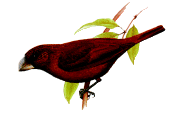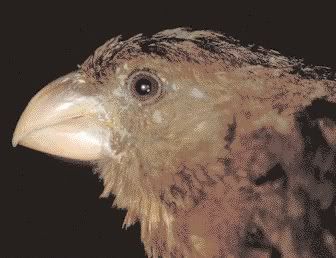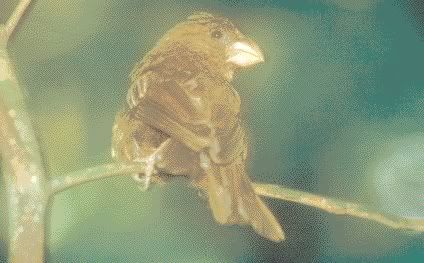|
|
Post by Melly on Jan 30, 2005 14:21:19 GMT
The Sao Tome Grosbeak (Neospiza concolor) was rediscovered in 1992 and photographed for the first time in 2001. www.ggcg.st/birds/grosbeak.htmThis photograph is a little confusing because the bird is barely seen. |
|
|
|
Post by sebbe67 on Apr 25, 2006 20:46:23 GMT
This species qualifies as Critically Endangered because it has a tiny population. It occupies a very small area of primary forest which, although it is not threatened, remains unprotected and might be vulnerable in the future. It is unclear whether introduced predators are impacting its population. Family/Sub-family FRINGILLIDAE Species name author (Barboza du Bocage, 1888) Taxonomic source(s) Dowsett and Forbes-Watson (1993), Sibley and Monroe (1990, 1993) Identification 18 cm. Large, chunky finch with massive bill. Uniformly rusty-brown on upperparts and underparts, slightly darker on head, wings and tail. Greyish-buff bill. Similar spp. Príncipe Seed-eater Serinus rufobrunneus is much smaller. Population estimate Population trend Range estimate (breeding/resident) Country endemic? <50 unknown 16 km2 Yes Range & population Neospiza concolor was, until recently, known only from three 19th century specimens from southern São Tomé, São Tomé e Príncipe. It was rediscovered in 1991, close to the rio Xufexufe in the south-west of the island5. Since then, there was a possible sighting in 1992, and sightings of a adults and a juvenile near the Xufexufe in 19973,4. Sightings continue to be reported from the Xufexufe and São Miguel areas6,7. Given the limited area of suitable habitat and the paucity of records it probably has a tiny population. Important Bird Areas Click here to view map showing IBAs where species is recorded, including sites where the species does not meet any IBA criteria. Ecology It occurs in lowland, closed-canopy primary forest. It is probably a canopy species and is reportedly quite silent, which could partly explain why it has so rarely been seen1. Recently, however, some vocalisations have been recorded6. Threats Historically, large areas of lowland forest were cleared for cocoa plantations. Today, land privatisation is leading to an increase in the number of small farms and the clearance of trees. This does not currently affect primary forest but may be a threat in the future. Road developments along the east and west coasts are increasing access to previously remote areas2. Introduced Black Rat Rattus rattus, Mona Monkey Cercopithecus mona, African Civet Civettictis civetta and Weasel Mustela nivalis are potential predators. Conservation measures underway Protection of primary forest as a zona ecologica and a national park has been proposed. A new law providing for the gazetting of protected areas and the protection of threatened species awaits final ratification2. Conservation measures proposed Research its population size, distribution, ecological requirements and key threats in order to produce conservation recommendations. Ensure legal protection of all primary forest. List it as a protected species under national law.  |
|
|
|
Post by Melanie on Nov 13, 2007 5:44:02 GMT
Photographes of the Sao Tome Grosbeak   |
|
|
|
Post by surroundx on Mar 11, 2017 11:31:55 GMT
|
|
|
|
Post by Melanie on Mar 24, 2017 16:14:24 GMT
|
|
|
|
Post by Melanie on Mar 24, 2017 16:18:37 GMT
|
|
|
|
Post by Melanie on Jan 8, 2022 6:04:55 GMT
Genomic signatures of isolation, hybridization, and selection during speciation of island finchesMartin Stervander, Martim Melo, Peter Jones, Bengt Hansson bioRxiv 2022.01.05.474904; Abstract Sister species occurring sympatrically on islands are rare and offer unique opportunities to understand how speciation can proceed in the face of gene flow. The São Tomé grosbeak is a massive-billed, 'giant' finch endemic to the island of São Tomé in the Gulf of Guinea, where it has diverged from its co-occurring sister species the Príncipe seedeater, an average-sized finch that also inhabits two neighbouring islands. Here, we show that the grosbeak carries a large number of unique alleles different from all three Príncipe seedeater populations, but also shares many alleles with the sympatric São Tomé population of the seedeater, a genomic signature signifying divergence in isolation as well as subsequent introgressive hybridization. Furthermore, genomic segments that remain unique to the grosbeak are situated close to genes, including genes that determine bill morphology, suggesting the preservation of adaptive variation through natural selection during divergence with gene flow. This study reveals a complex speciation process whereby genetic drift, introgression, and selection during periods of isolation and secondary contact all have shaped the diverging genomes of these sympatric island endemic finches.
|
|